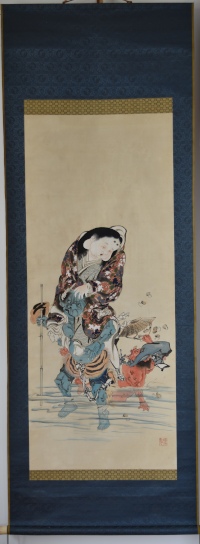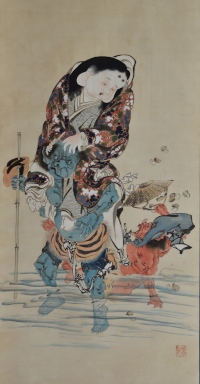/category/available/
Utagawa KUNIYOSHI (1797-1861)
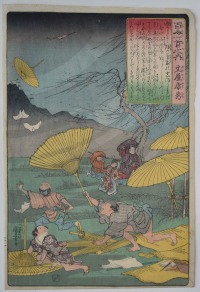
Click here to view image full size.
A poem by the celebrated poet Bunya no Yasuhide from the series Hyakunin isshu no uchi, “One Hundred Poems for One Hundred Poets” which was compiled in 1235 by Fujiwara Teika (1162-1241). The poet in the background watches as a fierce wind blows away some of the umbrellas that are being made. One of the best designs in the set published by Ebisuya Shoshichi, Ebine, 1840-42. Only 58 of the 100 are known. Various translations of the poem exist, here is one:
The mountain wind in autumn time
Is well called “hurricane”;
It hurries canes and twigs along,
And whirls them o’er the plain
To scatter them again
Very fine impression. Fine colour. Slight nibbling of border but otherwise fine condition. Signed Ichiyusai Kuniyoshi ga.
Status: Available
Utagawa KUNIYOSHI (1797-1861)
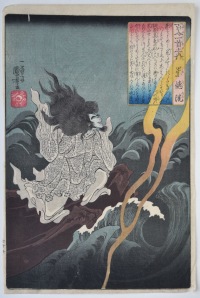
Click here to view image full size.
A poem by the celebrated poet Sutoku-in from the series Hyakunin isshu no uchi, “One Hundred Poems for One Hundred Poets” which was compiled in 1235 by Fujiwara Teiki (1162-1241). Shows the exiled Emperor Sutoku (1119-64) standing on a rocky outcrop above turbulent rapids. His wrath causes a thunderstorm with lightening. One of the very best designs from the set. Published by Ebisuya Shoshichi, Ebine, 1840-42. Only 58 of the 100 prints are known. Various translations of the poem exist, here is one:
Because the current is swift
Even though the rapids
Blocked by a boulder
Are divided, like them, in the end
We will surely meet, I know
Very fine impression. Fine colour. Very good condition. Signed Ichiyusai Kuniyoshi ga.
Status: Available
Tsukioka YOSHITOSHI (1839-1892)
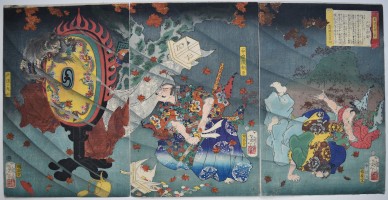
Click here to view image full size.
A triptych from a set Bidan musha hakkei, “Eight Views of Warriors’ Fine Tales.” This design Togakushi no seiran, “Clearing Weather of the Togakushi Mountains.” Princess Sarashina, who is actually a female oni called Momji, “Maple Leaves,” having transformed herself, is seen screaming from behind a giant drum and raising a high wind scattering maple leaves against Taira no Koremori Ason who draws his sword to kill her. Published by Sanoya Tomigoro, 1868.
Extremely fine impression of the earliest state. Fine colour. Slight marks on first sheet, otherwise very good condition. Signed Gekko Yoshitoshi hitsu.
Status: Available
Utagawa KUNISADA (1786-1865)
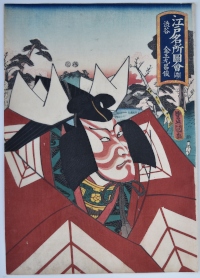
Click here to view image full size.
The actor Ichikawa Danjuro VIII as Shibuya Konnomaru Masatoshi from a set Edo meisho zue, “Famous Places of Edo.” This being Shibuya. Published by Iseya Chusuke 1852.
Very good impression. Good colour and condition. Signed Toyokuni ga.
Status: Available
Utagawa KUNISADA (1786-1865)
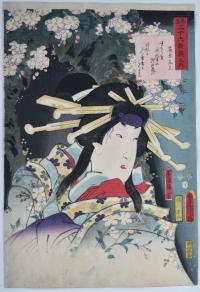
Click here to view image full size.
The actor Segawa Kikunojo III as the Spirit of the Komachi Cherry Tree from a set Mitate sanjurokkasen no uchi, “An Imaginary Thirty-six Poets.” A famous early compilation; in this case the image is inspired by a poem of Fujiwara no Motozane. The spirit is the courtesan Kurozome who appears to combat the evil plans of Sekibei (actually Otomo no Kuronushi) to cut the tree down. Published by Iseya Kanekichi, 1852.
Fine impression. Fine colour. Very small binding holes otherwise very good condition. Signed Toyokuni ga.
Status: Available
Ichiyusai KUNIYOSHI (1797-1861)
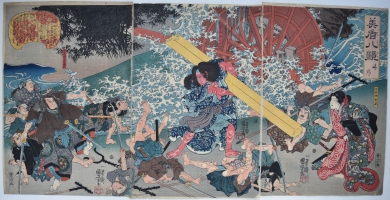
Click here to view image full size.
A triptych showing the legendary swordsman Miyamoto Musashi (centre) battling Shirakura Dengoemon (left) and his henchmen. The story usually relates how a jealous Dengoemon plots to kill Musashi by inebriating him and locking him in a bath house without his sword. However, Musashi, wielding a huge broken beam, slays Dengoemon and his followers aided by Dengoemon’s daughter Itohagi (right) who has fallen in love with Musashi. Kuniyoshi, however, depicts the event beside a mill-stream and a large waterwheel. Seiran, “Clearing Weather” from a set Mitate hakkei, “Selection for the Eight Views.” Published by Joshuya Juzo, 1846.
Very good impression, colour and condition. Signed Ichiyusai Kuniyoshi ga.
Status: Available
Tsukioka YOSHITOSHI (1839-1892)
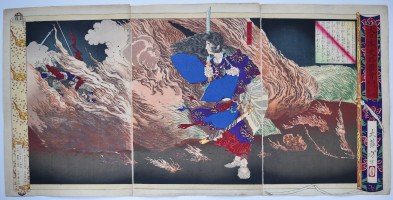
Click here to view image full size.
A triptych from a set of ten: Dai Nippon shiryaku zue, “Short Illustrated History of Great Japan.” Each print is in the form of an unrolled makimono. This design shows the third son of the twelfth century Emperor Keiko, Yamato Takeru no mikoto (Wo-usu). His father was constantly sending him on dangerous missions making him suspect that he wished his death. One such journey was to the Emishi in northeast Japan. On complaining about this to his high-priestess aunt, Yamatohime, she gave him the famous sword Ame no murakumo no hoken to aid him. On his arrival, the ruler of the Emishi lured him onto open grassland which he set on fire. Wo-usu used his sword to cut the grass, evade death, and start new fires to kill his enemy. Published by Kobayashi, 1880. A fine design.
Fine impression of first edition. Fine colour. Very slight crease bottom margin of centre sheet, otherwise fine condition. Signed Taiso Yoshitoshi.
Status: Available
Ichirakutei EISUI (Active 1790-1823)
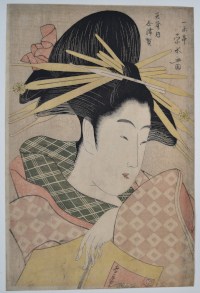
Click here to view image full size.
A fine okubi-e (“large head”) portrait of the courtesan Shizuka of the Tama-ya House. Eisui, like the other main pupils of Eishi, produced some of the finest bust-portraits in Ukiyo-e. Published by Maruya Bunemon c late 1790’s. Other impressions illustrated in Klaus J. Brandt, Hosoda Eishi, page 72, 524, no. C35, catalogued p. 231, and the Library of Congress, FP2-JPD, no. 1912. Extremely Rare.
Very good impression. Good colour. Slight soil, otherwise good condition. Full sze. Signed Ichirakutei Eisui ga.
Status: Available
Toyohara CHIKANOBU (1838-1912)
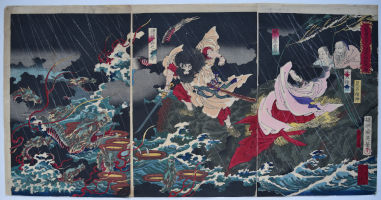
Click here to view image full size.
A triptych showing the Shinto Storm God Susanoo about to slay the eight-headed dragon, Yamata no Orochi, at the head of the Hi River in pouring rain. The dragon devoured virgins and had eaten the seven daughters of two earthly deities, seen top right. The eighth, Kushi-inada-hime, also on the right, is saved by Susanoo who encourages the dragon to drink eight-times brewed sake from eight vats which intoxicates it enough to be killed. Rare: Chikanobu is not known for this type of subject. Published c 1870s.
Fine impression, colour and condition. Mica applied to sky and the rain printed in silver. Full size. Signed Yoshu Chikanobu hitsu.
Status: Available
Utagawa TOYOKUNI I (1769-1825)
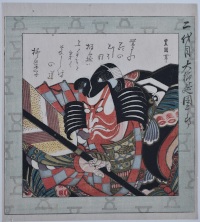
Click here to view image full size.
A surimono showing the actor Ichikawa Danjuro II as Soga no Goro Tokimune holding the giant arrow prior to sharpening it on the large wetstone from the play Yanone Goro. From a series of surimono that paid tribute to the various generations of the Danjuro family. There are two versions of this set of surimono and some ambiguity as to which is the earlier. They are known with blank borders, lacking metallic pigments and signed Ko Toyokuni hitsu (except one design signed Toyokuni II and probably issued in 1833). The other, as here, is signed Toyokuni hitsu, has metallic pigments and the emblem of the Gogawa Poetry Club around the border. The poets were also changed for this issue. It seems that the first version was issued by the Danjuro Fan Club in 1825 and that the reissue, c 1830s, was by the Gogawa. One poem by Ryueishi. The finest design from the set.
Very fine impression with metallic pigments. Fine colour and condition. Signed Toyokuni hitsu.
Status: Available
Kubo SHUNMAN (1757-1820)
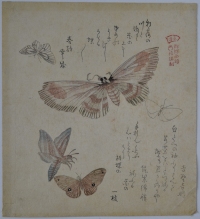
Click here to view image full size.
One of a series of surimono with title: Guncho gafu, “ Pictorial Record of a Swarm of Butterflies.” (In fact butterflies and moths.) Shunman is recognised as possibly the greatest designer of surimono and the prints from this set are amongst the most beautifully printed in this field. His family were printers and this would explain their particular excellence. In fact it is possible that Shunman engraved and printed himself which would account for his seal on other artists’ surimono. Issued c 1810s by the Kasumi-ren poetry club. (Their seal above the signature, top right, Kasumi-ren guncho gafu.) There are copies of the prints from this set which can be very misleading. Two other genuine impressions are in Harvard, 1933.4.1375 and the Met, JP2356.
Very fine impression. Fine colour. Slight discolouration and crinkling at the corners, otherwise good condition. Signed Sho Shunman sei.
Status: Available
Utagawa KUNIYOSHI (1798-1861)
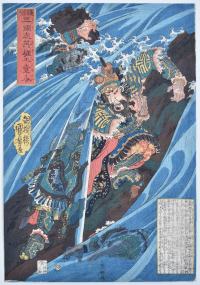
Click here to view image full size.
Cao Cao (Jap. Shuso) and Pang De (Jap. Hotoku) in the Han river during the battle with Guan Yu. From a set of Chinese warrior prints: Tsuzoku sangokushi eiyu no ichinin, “Heroes of the Popular History of the Three Kingdoms.” Published by Joshuya Kinzo, c. 1836. Robinson S10.8 (although only known as a key-block proof). Rare.
Superb impression. Very fine colour and condition. As the day it was printed. Signed Chooro Kuniyoshi ga.
Status: Available
Utagawa KUNIYOSHI (1797-1861)
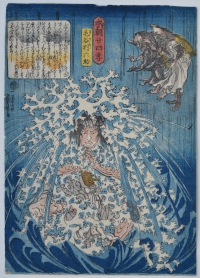
Click here to view image full size.
A fine chuban design showing Keyamura Rokusuke (aka Kida Magobee Muneharu), a famous farmer turned samurai and sumo wrestler of incredible strength, doing penance for seven days under the waterfall at Hikosan Gongen praying for his mother. Two Tengu watch from above. Waterfalls were one of the go-to-places to perform filial piety as they were considered to purify the soul in Shinto/Buddhist culture. From a set Honcho nijushiko, “Twenty-four Paragons of Filial Piety of our Country.” Published by Murataya Tetsu, 1843-6.
Fine impression and colour. Small nick out of top, otherwise very good condition. The signature Ichiyusai Kuniyoshi ga is on the extreme left edge and is often trimmed.
Status: Available
Mori SOSEN (1747-1821)

Click here to view image full size.
An original painting, sumi and light colour on silk, 42.5 x 16 in; 108 x 40.5 cms. His life is not well documented but he is known to have studied under the Kano artist Yamamoto Joshunsai (?-1781) before being drawn into Maruyama Okyo’s (1735-1795) artistic circle and his style is more Shijo than anything else. His animal paintings were evidently highly valued by Okyo. He was an immediate favourite with eastern collectors because of his monkey paintings at which he excelled, although he was more versatile than literature implies and highly accomplished at painting other animals. But his images of monkeys take precedence and he is considered the pre-eminent painter, east or west, on this subject. It is alleged that he lived in the woods for three years eating fruit and nuts to study the monkeys and other animals, and is also supposed to have had a cage of monkeys at the back of his house to better observe them. This high quality painting shows two monkeys sitting on the branch of a cherry tree. Signed Sosen with two Sosen seals. In good condition.
Status: Available
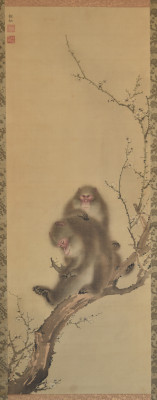
Click here to view image full size.
Kawanabe KYOSAI (1831-1889)
Click here to view image full size.
A fine original Kyosai painting, full colour on paper, 51.5 x 21.5 in; 131 x 54.5 cms. Shows Otafuku being carried across a river on the back of a blue oni. They look down with consternation at a red oni who has fallen into the water spilling his basket of mushrooms. The face of the blue oni takes on the appearance of Hyottoko, the male pairing of Otafuku. Known as the Goddess of Mirth, Otafuku is often shown with the Seven Gods of Good Fortune. There are various theories as to her origins and her face, in the form of a mask, has become ubiquitous. Kyosai was a draughtsman of great dexterity with a wild, often bizarre, imagination. Loved sake, sometimes painting under its influence. At an early stage studied under Kuniyoshi, then Maemura Towa and later Kano Chinshin before becoming an independent painter at 27. Adept at highly finished paintings but also produced a large corpus of spontaneous paintings.
In very good condition. Provenance: The inside of the lid on the box is signed and sealed by Mano Gyotei (Kyotei) who was Kyosai’s pupil and guarantees the painting. Sealed Kyosai.
Status: Available
Keisai EISEN (1790-1848)

Click here to view image full size.
An amorous couple from an unsigned abuna-e (from abunai, risqué) set of twelve prints Keisai higo, “Secret Words of a Courtesan” published c. 1822-25. Although coming under the heading of shunga, each print is without any graphic details. She adjusts his hair with her hairpin while he smokes a pipe.
Fine impression, colour and condition. (Without centre fold, which is often encountered on this set.
Status: Available
Kikugawa EIZAN (1787-1867)
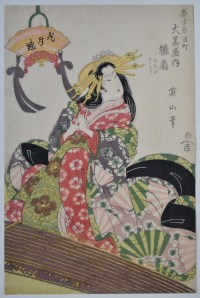
Click here to view image full size.
The geisha Hinaogi of the Daikokuya preparing to play the koto. She is adjusting the tsume (plectra) on her fingers that were used to pluck the strings. The title is enigmatic: It reads Ka getsu kai, “Harbinger of Moon and Flower” and if the character for “moon” is omitted it reads “oiran” (the highest ranking courtesan). Published by Enomotoya Kichibei, c. early 1830s. There is in fact a later copy of this print by Kunisada.
Fine impression. Excellent colour. Very good condition. Signed Eizan hitsu.
Status: Available
Utagawa HIROSHIGE (1797-1858)
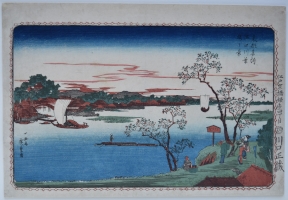
Click here to view image full size.
Sumidagawa hazakura no kei, “Cherry Trees along the Sumida River” from a Toto meisho “Famous Places in the Eastern Capital” set of ten prints published c 1831-2 by Kawaguchiya Shozo. Hiroshige’s first landscape set. The first editions, as here, have decorative borders adding a western element into the design. These were removed on later editions. There are also variant states with different shading. Rare.
Fine impression and colour. Backed, otherwise very good condition. Prints from this set are often missing or have the publisher’s name and address on the right border trimmed. Signed Ichiyusai Hiroshige ga. (The last set to be signed like this.)
Status: Available
Utagawa HIROSHIGE (1797-1858)
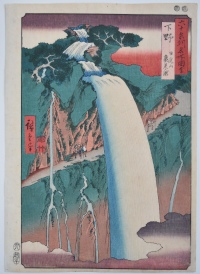
Click here to view image full size.
Shimotsuke Nikkosan urami no taki, “Back-viewed Waterfall on Mt. Nikko in Shimotsuke [Province].” From a set of 69 prints [Dai Nihon] Rokujuyoshi meisho zue, “Famous Places in the Sixty-odd Provinces [of Japan]” published by Koshihei between 1853 and 1856, this being 1853. Figures gaze up at the back of the waterfall which thunders over the path. It is also known with variant colour schemes. Fine design.
Very fine impression with strong blind-printing on the fall. Fine colour and condition. Full size. Signed Hiroshige ga.
Status: Available
Kitagawa UTAMARO (1754-1806)
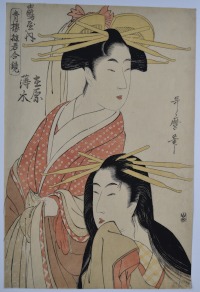
Click here to view image full size.
A double-bust portrait of the famous courtesans Ariwara (bottom) and Usumizu of the Tsuruya House in the Yoshiwara, Edo. From a set Seiro yukun awase kagami, “Mirror of Courtesans of the Green Houses.” Published by Yamada, c 1797.
Fine impression. Very good colour. Very slight trimming, otherwise very good condition. Signed Utamaro hitsu.
Status: Available
Kitagawa UTAMARO (1754-1806)
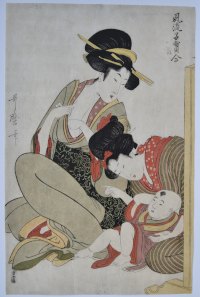
Click here to view image full size.
A design from a set of six prints Furyu ko-dakara awase, “Elegant Comparisons of Little Treasures.” About to breastfeed (chichi). Published by Izumiya Ichibei, c 1802.
Fine impression. Extremely well preserved colour. Very good condition. Signed Utamaro hitsu.
Status: Available
Ikeda EISEN (1790-1848)

Click here to view image full size.
A beauty, Ureshi so, “The Contented Type” from a set Imayo bijin junikei, “Twelve Views of Modern Beauties.” Above on a handscroll is a view of Fuji from Takanawa. She bites onto a tissue which has erotic connotations. Published c 1822-25 by Izumiya Ichibei.
Fine impression and colour. Very good condition. Signed Keisai Eisen ga.
Status: Available
Utagawa KUNIYOSHI (1797-1861)
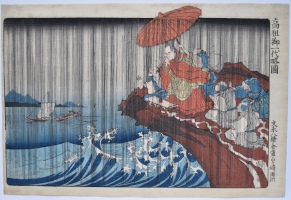
Click here to view image full size.
The priest Nichiren standing on the rocky promontory at Reizan in Kamakura and having his prayers for rain answered. The event occurred in 1271. His disciples surround him and protect him from the deluge with a large umbrella. Bunei hachi Kamakura Reizan-ga-saki uki. The second best design from Koso [Nichiren] goichidai ryakuza, “Illustrated Abridged Biography of the Founder.” Nichiren (1222-1282) was the founder of the Buddhist Nichiren sect (Nichiren shu – Kuniyoshi being a follower) and indeed the set of ten prints may have been commissioned to mark the 550th anniversary of his death. Published by Iseya Rihei, c 1831.
Fine impression, colour and condition. Ample room on top border for the umbrella which protrudes beyond the border and is often trimmed off, as is the information on right border. Signed Ichiyusai Kuniyoshi ga.
Status: Available
Utagawa YOSHITORA (1836-1887)
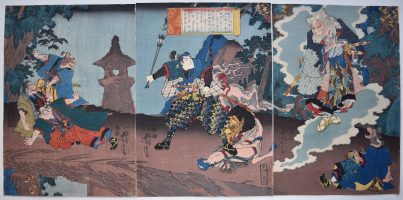
Click here to view image full size.
A triptych showing the warrior Inukai Genpachi (the famous character from the Hakkenden) confronting a cat monster which has emanated from a horse on Mount Koshin. Other cat monsters stare in amazement. Published by Kojimaya Jubei, 1850.
Very fine impression. Fine colour. Imperceptible small binding holes, otherwise fine condition. Signed Ichimosai Yoshitora ga.
Status: Available
Tsukioka YOSHITOSHI (1839-1892)
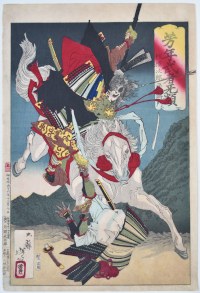
Click here to view image full size.
Shows Sagami Jiro Taira no Masakado on horseback attacking an opponent and having cut his sword in two. From a set Yoshitoshi musha burui, “Yoshitoshi’s Courageous Warriors.” Published by Kobayashi Tetsujiro, 1883.
Very fine impression: This is the first edition with three-colour cartouche and small red seals in left margin. There are late editions of this set. It was republished by Tsunajima Kamekichi in 1886. Fine colour. Slight soil bottom edge, otherwise very good condition. Signed Taiso Yoshitoshi ga.
Status: Available
Tsukioka SETTEI (1710-1786)

Click here to view image full size.
An original painting, sumi and full colour on silk, 38 x 12.5 in; 96 x 32 cms. Settei produced many illustrated books but after around 1765 turned towards painting beauties, courtesans and geishas. They are of the utmost refinement – the faces and limbs often delineated in red and their costumes embellished with gold. Settei is also known for his elegant shunga. A beauty looks towards a weeping willow. Painted c 1770. In good condition with an elaborately stencilled and embroidered mount. Details picked out in gold.
Signed Hokkyo Tsukioka Settei dzu and sealed o’Shinten.
Status: Available
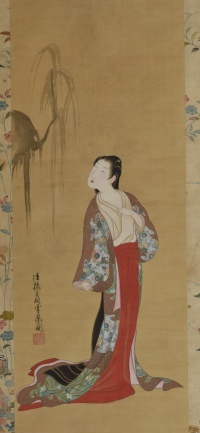
Click here to view image full size.
Matsumura KEIBUN (1779-1843)

Click here to view image full size.
An original painting, sumi and very light colour on paper, 52.5 x 20 in; 133.5 x 51 cms. Keibun studied with his older half-brother Matsumura Goshun as well as Maruyama Okyo. At his best, the equal of Goshun. Noted for his kachoga, as here, showing a bird on a flowering branch and a gourd vine.
In good condition. Signed and sealed Keibun.
Status: Available
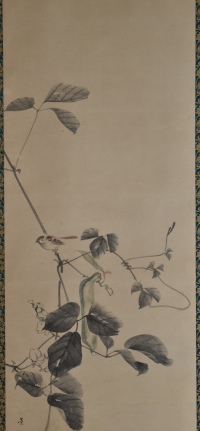
Click here to view image full size.
Hishikawa MORONOBU (?-1694)

Click here to view image full size.
A large sumizuri-e from a shunga set of twelve published c 1680s. In each case the couples are enclosed in a Chinese-style fan border. A couple in flagrante delicto beside an engawa with a bird cage. Moronobu was possibly the single most influential artist and pioneered the ukiyo-e school. A painter, printer and illustrator.
Very good impression. Minor marks, otherwise good condition.
Status: Available
Hishikawa MORONOBU (?-1694)

Click here to view image full size.
A large sumizuri-e from a shunga set of twelve published c 1680s. In each case the couples are enclosed in a Chinese-style fan border. A couple in flagrante delicto. Moronobu was possibly the single most influential artist and pioneered the ukiyo-e school. A painter, printer and illustrator.
Very good impression. Minor marks, otherwise good condition.
Status: Available
Hishikawa MORONOBU (?-1694)

Click here to view image full size.
A large sumizuri-e from a shunga set of twelve published c 1680s. In each case the couples are enclosed in a Chinese-style fan border. A couple in flagrante delicto. Moronobu was possibly the single most influential artist and pioneered the ukiyo-e school. A painter, printer and illustrator.
Very good impression. Minor marks, otherwise good condition.
Status: Available
Hishikawa MORONOBU (?-1694)

Click here to view image full size.
A large sumizuri-e from a shunga set of twelve published c 1680s. In each case the couples are enclosed in a Chinese-style fan border. A couple in flagrante delicto. Moronobu was possibly the single most influential artist and pioneered the ukiyo-e school. A painter, printer and illustrator.
Very good impression. Minor marks, otherwise good condition.
Status: Available
Hishikawa MORONOBU (?-1694)

Click here to view image full size.
A large sumizuri-e from a shunga set of twelve published c 1680s. In each case the couples are enclosed in a Chinese-style fan border. A couple in flagrante delicto. Moronobu was possibly the single most influential artist and pioneered the ukiyo-e school. A painter, printer and illustrator.
Very good impression. Minor marks, otherwise good condition.
Status: Available
Utagawa HIROSHIGE II (1826-1869)
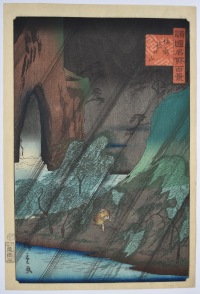
Click here to view image full size.
The Dragon’s Maw Mountain, Bizen Province, Bizen tatsu-no-kuchiyama from Shokoku meisho hyakkei, “Hundred Views of Famous Places in the Provinces.” An uncompleted set of 81 prints published by Uoya Eikichi between 1859-1861 (this being 1861). Shows a lone figure battling a heavy rainstorm in a steep-sided canyon.
Superb impression of the first edition. Fine colour and condition. Signed Hiroshige ga.
Status: Available
Utagawa HIROSHIGE II (1826-1869)
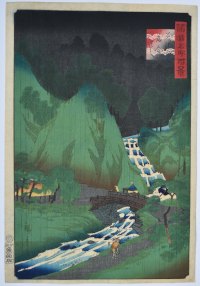
Click here to view image full size.
Mino Ochiai-bashi. Mino (Noshu) Province from Shokoku meisho hyakkei, “Hundred Views of Famous Places in the Provinces.” An uncompleted set of 81 prints published by Uoya Eikichi between 1859-1861 (this being 1861). An evening rain scene with figures making their way across the torrential Chitose River, famous for its fishing.
Superb impression of the first edition. Fine colour and condition. Signed Hiroshige ga.
Status: Available
Utagawa KUNISADA (1786-1864)

Click here to view image full size.
A beauty washing in a large tub of water. Kiku,”Chrysanthemum” from a set Tosei hana kurabe, “Contest of Modern Flowers.”Beauties compared to flowers. Published by Omiya Heihachi, c 1820. This appears to be the earliest state with the beauty’s undergarment printed red which is lacking in other impressions.
Very good impression. Fine colour. Very good condition. Signed Gototei Kunisada ga.
Status: Available
Utagawa KUNISADA (1786-1864)
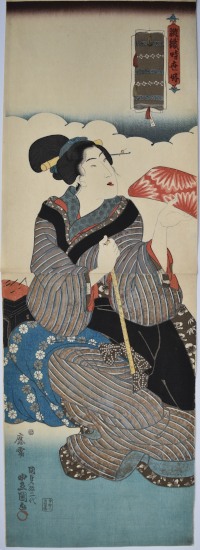
Click here to view image full size.
A vertical double oban showing a woman holding a ruler and offering a small bolt of cloth with the other hand. From a set Atsurae ori jisei konomi, “Fabrics to Order in Current Taste.” Published by Yamashiroya Jinbei, c 1843-7. A rare design from a rare set, and even rarer to find in this condition as most examples have been mounted and consequently damaged from being hung.
Very fine impression. Fine colour and condition. Signed Oju Kunisada aratame Nidai Toyokuni ga.
Status: Available
Tsukioka YOSHITOSHI (1839-1892)
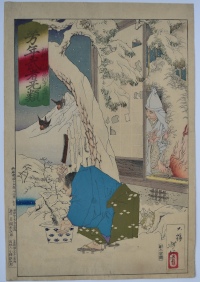
Click here to view image full size.
Shows Sano Genzaemon Tsuneyo in his snowy garden about to cut his precious bonsai to provide kindling to cook a meal for an unexpected visitor. The guest, disguised as a monk, was in fact the retired regent Hojo Tokiyori (1226-1263) on an intelligence mission. He is shown peering through the shoji. From a set Yoshitoshi musha burui, “Yoshitoshi’s Courageous Warriors” published by Kobayashi Tetsujiro, 1883. This is the first edition with the heavily variegated cartouche. Some first editions from the set also have red seals in the left margin and some also have the panels below coloured.
Very good impression, colour and condition. Signed Taiso Yoshitoshi ga.
Status: Available
Utagawa YOSHIIKU (1833-1904)
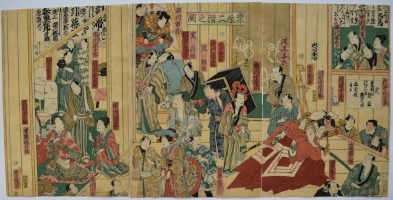
Click here to view image full size.
A fascinating triptych showing the backstage activities on the second floor of a kabuki theatre, Gakuya ni-kai no zu. Twenty-one actors are shown, mostly in their street clothes, together with assistants. However, on the right sheet can be seen an actor in full Shibaraku costume while the centre sheet has Ichikawa Ichizo III descending the stairs. Below is the actor Bando Mitsugoro VI in an onnagata role. On the left sheet can be seen another actor in an onnagata role applying his makeup. This is the bottom half of a hexaptych. Published by Izutsuya Shokichi, c 1861. This design is loosely based on the bottom half of a hexaptych designed by Kunisada in 1856. Rare.
Very good impression and colour. Minor defects, otherwise very good condition. Signed Yoshiiku ga.
Status: Available
Toyohara KUNICHIKA (1835-1900)
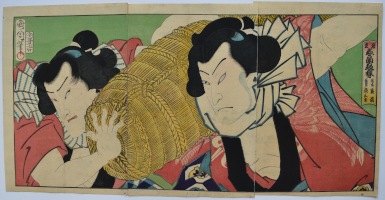
Click here to view image full size.
A triptych with the title Mitate haruzumo futatsu chocho, “An Imaginary Spring Sumo Match with two Butterflies.” A parody of the famous Sumoba, “Sumo Scene” in the pay Futatsu chocho kuruwa nikki, “A Diary of two Butterflies in the Pleasure Quarters.” Shows the actors Ichimura Kakitsu IV (left) as the wrestler Chokichi and Bando Hikosaburo V (right) as his rival Chogoro. The names of both wrestlers begin with “Cho” and two of them together makes “Chocho” which also means “butterfly.” Published by Otaya Takichi, 1866.
Very good impression and colour. Backed, otherwise very good condition. Signed Kunichika ga.
Status: Available
Katsukawa SHUNSHO II (Active 1818-1830)
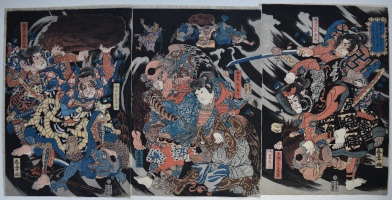
Click here to view image full size.
Minamoto no Yoshinaka Shitenno to tomoni Kiso no okuyama ni Tengu o taiji su, “Minamoto Yoshinaka and His Four Retainers Defeat the Tengu in the Deep Mountains of Kiso.” Minamoto no Yoshinaka is seen in the centre panel, Higuchi Kanemitsu on the right holding a sword and Imai Kanehiro on the left panel. Tengu are winged demons or spirits known for their fencing abilities, have long noses or bird-like beaks, and are associated with the ascetic practise of Shugendo and wear the garb of its followers, the Yamabushi. Published by Fujiokaya Hikotaro. Rare: Another impression is in MFA, Boston, accession number 11.21594-6.
Fine impression. Very good colour and condition. Signed Shunsho ga.
Status: Available
